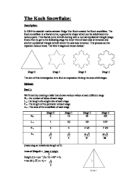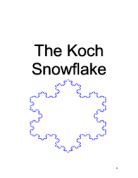Pn = Nn × ln. As for the area of the diagram, it is equal to the area of the original triangle plus the area of the new smaller triangles added in each step, and since it’s an equilateral triangle its height (the original triangle) is equal to (√3)/2, which was found from the fact that the angels of the equilateral triangle are 60o, and using a segment which bisected the base and was normal to it. So using known famous triangles which the angles 30 o, 60 o, and 90o
** Each graph of every single set of values plotted against the value of n, are in the following pages respectively.
Number of Sides (Nn)
One side of the figure from the previous stage becomes four sides in the following step, thus we begin with three sides, and the general expression for the number of sides in the Koch Snowflake will be:
Nn = 3(4) n
At the nth stage.
For iterations 0, 1, 2 and 3, the number of sides is 3, 12, 48 and 192, respectively.
Or it can be derived from the value of Nn from the zero stage till the third stage
N0= 3, N1= 12, N2=48, N3=192
N0= 3(1), N1= 3(4), N2= 3(16), N3 = 3(64)
N0= 3(4)0, N1=3(4)1, N2=3(4)2, N3= 3(4)3
Hence, Nn= 3(4)n
Length of a single side (ln)
As we proceed in each stage the length of any side is 1/3 the length of the side from the preceding stage. If we begin with an equilateral triangle with side length 1, then the length of a side in nth iterations is
ln = 1/ (3)n
For stage 0 to 3, ln = 1, 1/3, 1/9 and 1/27.
Or as in the above it can from the value of ln from the zero stage till the third stage
l0=1, l1=1/3, l2= 1/9, l3= 1/27
l0=1/ (3)0, l1=1/ (3)1, l2= 1/ (3)2, l3= 1/ (3)3
And hence ln = 1/ (3) n
Perimeter (Pn)
Since the lengths of every side in every iteration of the Koch Snowflake are the same, then perimeter is simply the number of sides multiplied by the length of a side
Pn = (Nn) (ln)
Pn = (3(4) n) (1/ (3) n)
For the nth stage.
Again, for the first 4 steps (0 to 3) the perimeter is 3, 4, 16/3, and 64/9.
As we can see, the perimeter increases by 4/3 times each iteration so we can rewrite the formula as
Pn = 3(4/3) n
Or it can be derived from the value of Pn from the zero stage till the third stage
P0= 3, P1= 4, P2= 48/9, P3= 192/27
P0= 3, P1= 3(4/3), P2= 3 (16/9), P3= 3 (64/27)
P0= 3 (4/3)0, P1= 3(4/3)1, P2= 3(4/3)2, P3= 3(4/3)3
And hence Pn= 3(4/3) n
The area of the snowflake (An)
In each iteration we take the area of the previous snowflake or shape, and then add the area of all of the new smaller triangles added.
And the general expression can be derived from the values of An from the zero stage till the third stage
A0 = (√3)/4,
A1= (√3)/3, A1= [(√3)/4] + (1/3) ((√3)/4), A1= [(√3)/4] + (4/9)0(1/3) ((√3)/4)
A2= 10(√3)/27, A2= [(√3)/3] + ((√3)/27), A2= [(√3)/3] + (1/3) (4/9)1 ((√3)/4)
A3= 94(√3)/243, A3= [10(√3)/27] + (4(√3)/243), A3= [10(√3)/27] + (1/3) (4/9)2 ((√3)/4)
And hence we can see that the general expression is
An = An–1 + (1/3) (4/9) n–1((√3)/4)
From the general expressions above we can find Nn, ln, Pn, and An, at n=4.
Where that N4= 3(4)4=768, l4= 1/ (3)4= 1/81,
Pn = 3(4/3)4=256/27,
A4 = A4–1 + (1/3) (4/9) 4–1((√3)/4) = A3 + (1/3) (4/9)3((√3)/4)
= 0.654172
One side of the triangle through step 0 till step 4.
As n increases the area converges to a certain value where that the 1st six decimals are equal in the successive terms, and such patterns beings to appear at stage number seventeen where that A17= 0.691693219 and A18= 0.691693719, so we can see that An+1 = An to six places of decimals at n=17. For the other values as n get larger there is no value of n where that ln = ln+1 to six places of decimals.
The perimeter as n → ∞ the perimeter becomes very large going to infinity, and the area converges to 0.692820323 which is equal almost to (8/5) ((√3)/4) which is (8/5) the area of the original triangle at step 0.
Hereby the general expression for An will be proved by induction
A0= (√3)/4, A1= (√3)/3
An = An–1 + (1/3) (4/9) n–1((√3)/4) prove it is true for n=1
A1 = A1–1 + (1/3) (4/9) 1–1((√3)/4)
A1 = A0+ (1/3) (4/9)0((√3)/4)
A1 = (√3)/4+ ((√3)/12)
(√3)/3 = (4(√3)/12) = (√3)/3
Then Left hand side equals Right hand Side
Now assume it is true for n=k that is
Ak = Ak–1 + (1/3) (4/9) k–1((√3)/4)
Now we want to prove it is true for n = k+1
Ak+1 = A (k+1)–1 + (1/3) (4/9) (k+1)–1((√3)/4)
Ak+1 = A k+ (1/3) (4/9) k((√3)/4)
A1 = A0 + (1/3) (4/9)0((√3)/4)
(√3)/3 = [(√3)/4] + (1/3) ((√3)/4) = (4(√3)/12)
= (√3)/3
Since An is true for n=1, so it true for n=k, then it true for n= k+1, then is true for all values of n







